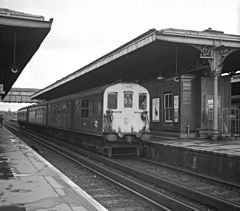British Rail Class 206 facts for kids
The British Rail Class 206 was a special type of train in the United Kingdom. It was a diesel-electric multiple unit, often called a DEMU. These trains were first created in 1964. People gave them a fun nickname: 'Tadpole' units!
Quick facts for kids British Rail Class 206 |
|
|---|---|

Class 206 3R unit at Guildford, June 1979
|
|
| In service | 1964 – early 1990s |
| Number built | 6 |
| Formation | unknown |
| Operator(s) | British Rail |
| Specifications | |
| Maximum speed | unknown |
| Prime mover(s) | English Electric 4-cylinder type 4SRKT Mark II of 500 bhp at 850 rpm |
What Was the Class 206?
The Class 206 was a type of train that ran on diesel fuel and used electricity to power its motors. It was made by combining parts from two other train classes. These were the Class 201 and the Class 416 trains.
Why Were They Created?
These trains were put together for a specific job. They were meant to run services on the North Downs Line. This route connected Reading, Redhill, and Tonbridge.
How Many Were There?
- Six train sets were made.
- Each set had three cars, or sections.
- Their numbers were 1201 through 1206.
The 'Tadpole' Nickname
The Class 206 trains got their nickname 'Tadpole' because of how they looked.
- One end of the train used a car from the Class 416. This part was wider.
- The other end used cars from the Class 201. These parts were narrower.
- This difference in width made the train look like a tadpole, with a wide 'head' and a narrower 'tail'.

All content from Kiddle encyclopedia articles (including the article images and facts) can be freely used under Attribution-ShareAlike license, unless stated otherwise. Cite this article:
British Rail Class 206 Facts for Kids. Kiddle Encyclopedia.
